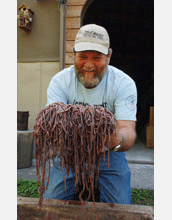Multimedia Gallery
Worm Grunting (Image 1)
Worm grunter Gary Revell admires the results of a day of worm grunting. Worm grunting is accomplished by driving a wooden stake into the ground and then rubbing the top of the stake with a long piece of steel called a rooping iron. The vibration makes a peculiar grunting sound--hence the name, worm grunting. The large endemic earthworm (Diplocardia mississippiensis) respond to the vibrations by emerging to the surface where thousands can be gathered in a few hours. Generations of families in and around Florida's Apalachicola National Forest in the Florida Panhandle have supported themselves by collecting the worms in this manner, which they sell as fish bait. [Image 1 of 3 related images. See Image 2.]
More about this Image
Ken Catania, an associate professor of biological sciences at Vanderbilt University, wanted to study the biological basis for worm grunting. Catania found that a population of the eastern American mole (Scalopus aquaticus) inhabits the area where the earthworms are collected. The earthworms have a pronounced escape response from the moles consisting of rapidly exiting their burrows to flee across the soil surface. But why, Catania wondered, do the earthworms suddenly exit their burrows in response to vibrations, thus exposing themselves to predators? Recordings of vibrations generated by bait collectors and moles suggest that "worm grunters" unknowingly mimic digging moles. An alternative possibility too is that the worms interpret the vibrations as rain, and surface to avoid drowning. However, this theory has not been supported.
Previous investigations have revealed that both wood turtles and herring gulls vibrate the ground to elicit earthworm escapes, indicating that a range of predators may exploit the predator-prey relationship between earthworms and moles. In addition to revealing a novel escape response that may be widespread among soil fauna, the results show that humans have played the role of "rare predators" in exploiting the consequences of a sensory arms race. To learn more about Catania's investigation, see the Plos One story, "Worm Grunting, Fiddling, and Charming--Humans Unknowingly Mimic a Predator to Harvest Bait." [The research was funded by a MacArthur Foundation fellowship and a National Science Foundation CAREER award (IBN 02-38364).] (Date of Image: 2008)
Credit: Kenneth Catania, Vanderbilt University
Images and other media in the National Science Foundation Multimedia Gallery are available for use in print and electronic material by NSF employees, members of the media, university staff, teachers and the general public. All media in the gallery are intended for personal, educational and nonprofit/non-commercial use only.
Images credited to the National Science Foundation, a federal agency, are in the public domain. The images were created by employees of the United States Government as part of their official duties or prepared by contractors as "works for hire" for NSF. You may freely use NSF-credited images and, at your discretion, credit NSF with a "Courtesy: National Science Foundation" notation.
Additional information about general usage can be found in Conditions.
Also Available:
Download the high-resolution JPG version of the image. (1.6 MB)
Use your mouse to right-click (Mac users may need to Ctrl-click) the link above and choose the option that will save the file or target to your computer.

